




Whether escaping the bustle of daily life with a beloved classic or discovering new worlds with the less familiar, come share the extraordinary this season with The Cleveland Orchestra .
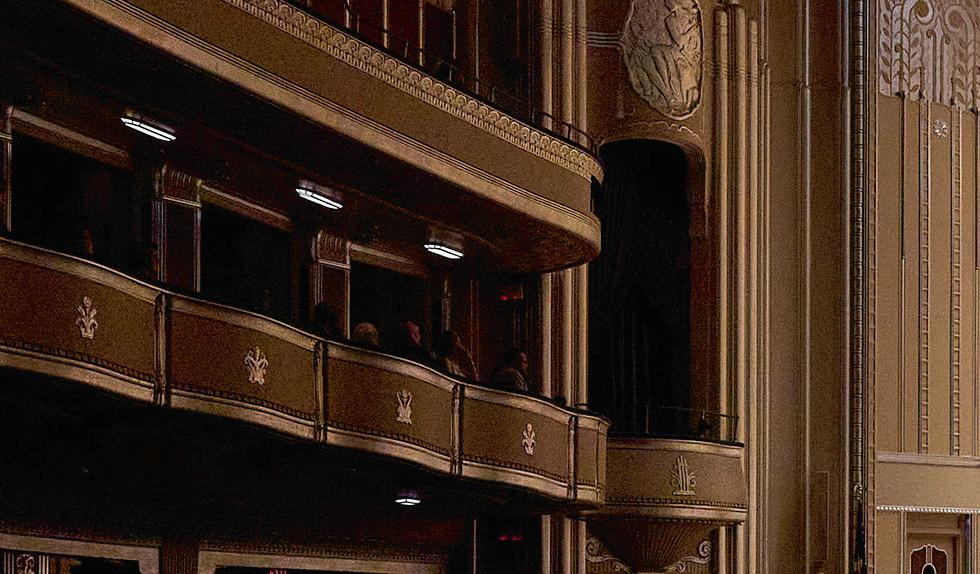



When you subscribe, you provide vital support to your Cleveland Orchestra and enjoy these exclusive benefits:
• The best seats at the best prices
• Free and easy ticket exchanges
•Purchase your parking in advance
• 20% off additional ticket purchases
• 10% off at The Cleveland Orchestra Store
•Money back guarantee

JACK, JOSEPH AND MORTON MANDEL CONCERT HALL AT SEVERANCE MUSIC CENTER
Thursday, April 4, 2024, at 7:30 PM
Saturday, April 6, 2024, at 8 PM
John Adams, conductor
Gabriella Smith (b. 1991)
Breathing Forests
Concerto for Organ and Orchestra
I. Grow—
II. Breathe
III. Burn
James McVinnie, organ
30 minutes
Claude Debussy (1862–1918)
John Adams (b. 1947)
INTERMISSION 20 minutes
Prélude à l’après-midi d’un faune 10 minutes (Prelude to the Afternoon of a Faun)
City Noir
I. The City and its Double —
II. The Song is for You
III. Boulevard Night
Timothy McAllister, saxophone
35 minutes
Total approximate running time: 1 hour 35 minutes
Thank you for silencing your electronic devices.
Continue your journey with John Adams and The Cleveland Orchestra on adella.live with two recent digital productions featuring Adams’s El Niño and America Through the Looking Glass, a program highlighting contemporary American composers.
People today can spend nearly half their lives over the age of 50. That’s a lot of living. So, it helps to have a wise friend and fierce defender like AARP in your corner and in your community so your money, health and happiness live as long as you do.
People today can spend nearly half their lives over the age of 50. That’s a lot of living. So, it helps to have a wise friend and fierce defender like AARP in your corner and in your community so your money, health and happiness live as long as you do.
AARP offers educational resources, engaging community events, and regular updates to help you achieve your goals and stay connected.
AARP offers educational resources, engaging community events, and regular updates to help you achieve your goals and stay connected.
Find us at aarp.org/oh.
Find us at aarp.org/oh.




MORE THAN A CENTURY separates the earliest work on this weekend’s program, Claude Debussy’s Prelude to the Afternoon of a Faun, which had its premiere in 1894, from the newest, Breathing Forests by Gabriella Smith, completed in 2021. (This work, written for organist James McVinnie, also provides a showcase for Severance’s newly restored Norton Memorial Organ.) What they have in common with each other and with the third work on the program, City Noir by John Adams, is a palpable sense of location, fashioned not with words or images but entirely in sound.
Debussy found inspiration for his piece in a poem published in 1876 by the French writer and critic Stéphane Mallarmé. A major figure in 19th-century Parisian culture, Mallarmé was a proponent of Symbolism, an arts movement that rejected realistic representation in favor of evocation and emotion. Yet in taking as his subject the sensual daydreams of a faun — a mythical half-man, half-goat — Debussy fashioned music that uncannily evokes a languid afternoon’s soft light and humidity.
Literature also moved Adams to compose City Noir: in his case, the eight-volume series Americans and the California Dream by historian Kevin Starr, which comprises a sprawling history of the state of California. Adams was specifically inspired by a portion of the sixth volume, Embattled Dreams, recounting the 1947 “Black Dahlia” murder case in Los Angeles. Adams taps into sensations plucked from lurid tabloid journalism, pulp fiction, and stark Hollywood film noir for his uniquely American symphony, deploying ominous shadows, neon-bright hues, and big-band jazz with the deft, vivid touch of a master cinematographer.
The Golden State provided inspiration for Smith as well, who had a specific place and time in mind when creating her 2021 organ concerto Breathing Forests: the California forests she’d grown up loving, massive portions of which had been devastated by recent wildfires heightened by climate change. In evoking majestic trees, wildlife, and nature’s fury, Smith expands upon a centuries-old tradition. But in addition to the warning it conveys, Breathing Forests is also meant as a joyous call to action.
— Steve SmithEARN POINTS
• Attend concerts
• Watch videos
• Answer quizzes
• Give feedback
GET REWARDS
• Seat upgrades
• Exclusive content
• FREE season of Adella with 3000 Rewards points
• VIP experiences and more
JOIN NOW

Already a member?
Log in to your account at my.clevelandorchestra.com and click “Rewards” in the menu.
CLEVELANDORCHESTRA.COM/REWARDS
216-231-1111





BORN : December 26, 1991, in Berkeley, California
▶ COMPOSED: 2021, revised 2023
▶ WORLD PREMIERE: February 11, 2022, with organist James McVinnie and the Los Angeles Philharmonic conducted by Esa-Pekka Salonen
▶ This weekend’s performances mark the first presentations of Gabriella Smith’s Breathing Forests by The Cleveland Orchestra.
▶ ORCHESTRATION: 2 flutes, piccolo, 3 oboes, 3 clarinets, 2 bassoons, 4 horns, 3 trumpets, 3 trombones, tuba, and strings, plus solo organ
▶ DURATION: about 30 minutes
“I GREW UP WANTING TO BE AN ECOLOGIST , and sort of became a musician by accident,” composer Gabriella Smith said, in a recent interview via video call from her home in Seattle. It’s a funny understatement if you’re aware of Smith’s burgeoning career: she’s been championed by senior composers like Steve Reich and John Adams (who conducts this concert), and commissioned by institutions like the Kronos Quartet, Los Angeles Philharmonic, and Carnegie Hall.
In a way, though, her statement foreshadows her organ concerto, Breathing Forests. Born in California’s Bay Area, Smith identifies herself as a composer “whose work invites listeners to find joy in climate action.” The word “joy” is crucial: Smith’s music acknowledges the reality of loss, but also exults in the
creative possibilities of taking responsibility and getting involved.
There’s ample precedent for concert-music composers working with instrumentalists to replicate aspects of the natural world. Think of Vivaldi’s vivid The Four Seasons, the passing storm in Beethoven’s “Pastoral” Symphony, the tempestuous seas of Wagner and Debussy.
More recently, composers have used those same tools, with new expressive notions and techniques, to evoke a climate in crisis. Become Ocean, by John Luther Adams, imagines seas rising as a result of polar ice melting. With Songs of the Ice, Outi Tarkiainen evokes an Icelandic glacier’s demise. Breathing Forests is a like-minded gesture, but with a key difference: Smith’s music is less lamentation than motivation.

The seed for the piece was planted when Smith met organist James McVinnie at a Los Angeles Philharmonic concert conducted by Adams, which featured her 2014 work Tumblebird Contrails. On the same program, McVinnie played in Philip Glass’s Symphony No. 12, “Lodger.”
As they became acquainted, McVinnie offered Smith a guided tour of the Walt Disney Concert Hall organ. Subsequently commissioned to write a new work for the LA Philharmonic, Smith set out to write a concerto for her friend. She also determined her work would respond to
the forest fires that had devastated the state in which she’d grown up, exacerbated by the increased drought and heat associated with climate change.
“The massive sound and architecture of the organ feels something like the grandeur of a forest to me,” Smith wrote in her poetic composer’s note for Breathing Forests, “and its breath reminiscent of the glorious exchange of carbon dioxide to oxygen that forests perform on a massive scale.”
Smith and McVinnie intended to collaborate closely in person during the work’s gestation, but the global COVID-19 pandemic intervened. Instead, via the internet, Smith sent photos and screenshots of her handwritten notes and computer-notated files. McVinnie responded with feedback that helped Smith understand what was practical and feasible for the instrument and its player.
That connection was critical — not least because Smith has a well-established penchant for employing unorthodox instrumental techniques, whereas the organ is, by dint of its fundamental architecture, an instrument that resists tinkering and tampering.
“That was one of the biggest challenges of writing this, and also one of the reasons I wanted to do it,” Smith explained. “I like everything I do to have an element of risk, because that’s what excites me and keeps me growing.”
In the end, she essentially left the organ to its own devices, using its monumentality to conjure the grandeur her conception required. She surrounded the organ with elemental strangeness and charm, devising an instrumental vocabulary enhanced with ghostly hisses, scrapes, bounces, and microtonal frissons.
“I saw the orchestra as the organ’s effects pedal, in a way,” she said. Smith described the effects she sought with words and symbols in her score. For the string players, she also recorded brief instructional videos accessible by scanning QR codes.
Breathing Forests adheres formally to
a Classical-era standard: a fast opening movement, slow centerpiece, and brisk finale, here played without pause. The first movement, “Grow,” opens with rustles, shimmers, and echoes of birdsong, the organ’s glowing sound and sheer presence giving the music an uncanny spirit.
“Breathe,” the middle movement, evokes a forest’s majestic stillness and buzzing hidden connections, punctuated with the cries and whispers of its animal inhabitants. “Burn,” the finale, rises from an eerie dry crackle and smolder to a fiery, chaotic climax. A brief, buoyant organ cadenza resolves into an enveloping sensation of radiance.
Paradoxically, along with nature’s fury, the music conveys joy — just as Smith intended. She presumes audiences are aware of what the climate crisis portends. What she wants to say is that action “is not only urgently needed, but incredibly fun and inspiring to be a part of as a community.”
“For a while I felt like, how do I write music about the climate crisis when I want to write music that’s uplifting?” Smith said. “And I realized, that’s the kind of music we need. It needs to feel real and profound. We need to feel our grief, and we need to feel the loss. But we also need to feel the joy in getting to work.”
— Steve Smith
Breathing Forests is a reflection on the complex relationship between humans, forests, climate change, and fire. The massive sound and architecture of the organ feels something like the grandeur of a forest to me, and its breath reminiscent of the glorious exchange of carbon dioxide to oxygen that forests perform on a massive scale. Because of their role as one of our planet’s biggest carbon sinks, forests are more essential now than ever before. But I can’t think of them without feeling an immense sadness that we are losing more and more of these forests each year. Growing up in California, I’ve experienced wildfire throughout my life, but never the massive and devastating wildfires that have now become the norm, exacerbated by climate change and increasing levels of drought and heat. At the same time, fire is a vital part of many ecosystems, and decades of fire suppression and policy against prescribed burns is also, in part, responsible for much of the devastation and loss of control of wildfires in recent years.
Breathing Forests is in three contiguous movements (I. Grow, II. Breathe, III.Burn) that roughly follow the traditional fast-slow-fast concerto form. The piece is a sonic forest, growing, breathing, burning, and regenerating, containing both sadness for the losses we can never get back, and joy — a celebration of forest ecosystems and their vital role in the fight against climate change, a celebration of all those participating in the fight for our future, and an invitation to get to work.
— Gabriella SmithBORN : August 22, 1862, in St. Germain-en-Laye, France
DIED: March 25, 1918, in Paris
▶ COMPOSED: 1892–94
▶ WORLD PREMIERE: December 22, 1894, by the Société Nationale de Musique in Paris, conducted by Gustave Doret
▶ CLEVELAND ORCHESTRA PREMIERE: October 23, 1919, led by Nikolai Sokoloff
▶ ORCHESTRATION: 3 flutes, 2 oboes, English horn, 2 clarinets, 2 bassoons, 4 horns, 2 harps, antique cymbals, and strings
▶ DURATION: about 10 minutes
THIS WAS DEBUSSY ’s first masterpiece and in many ways can be seen as the first masterpiece of 20th-century music — even though it predates the new century by six years.
It is at times difficult to comprehend how a mere 10 minutes of music for small orchestra can serve as a foundation stone for so much that came after. But whenever we hear this music, its magic is immediately apparent, as it was indeed to its first audience in 1894.
It is even harder to realize that these few pages, with their mysteriously improvisatory air, took Debussy two years of patient toil to put together. He was still relatively unknown in Paris and had not written anything close to the visionary step into the unknown that the Prelude represents.
In a sense, Debussy was simply
writing a symphonic poem on a literary text, as Richard Strauss, for example, had treated Lenau’s Don Juan a few years before. But Stéphane Mallarmé’s L’après-midi d’un faune (The Afternoon of a Faun) was no conventional narrative poem, and it left no scope for the direct matching of music and words.
Debussy’s intention was not to parallel the poem’s text, but to decorate it. In the note given out at the first performance, he explained: “The music of the Prelude is a very free illustration of Mallarmé’s fine poem. It is not meant to be a synthesis of it but rather a series of settings across which pass the desires and dreams of the faun in the heat of the afternoon.”
Many symphonic poems had merely evoked a tableau or a mood, but Debussy not only avoided any precision of

character and action, he allowed his music to develop in an altogether free way. From the very first bar, the music starts and evolves without clear-cut notions of thematic balance or tonal precision. The famous flute solo with which the music begins sounds like an improvisation, not a theme, and its musical key is far from clear. Each time this melody comes back, its shape and its harmonic background are different, like a continuous variation.
Once the flute solo has run its course, the clarinet, over a sharp horn chord, moves into a different atmosphere, laden with the whole-tone scales that Debussy had already marked as his own. When the oboe takes melodic charge, the warmth of the music grows from within.
The middle section, over throbbing string chords, betrays the faun’s unmistakable passion, and the flute
returns transfigured for the faun’s languid intoxication in the forest heat, interrupted by impulsive little movements and sudden charges of feeling. The closing pages have an epic dimension, as if a curtain is being closed on a whole world of poetic mystery.
The orchestration throughout is of extraordinary delicacy, with the multiple division of the strings (Debussy’s preferred string sound) with solo violin and solo cello for added sweetness, and two harps. No heavy brass is needed, no timpani. The only percussion is the pair of miniature cymbals whose spare notes are like sparkles of light in the forest.
— Hugh MacdonaldHugh Macdonald is Avis H. Blewett Professor Emeritus of Music at Washington University in St. Louis. He has written books on Beethoven, Berlioz, Bizet, and Scriabin, as well as Music in 1853: The Biography of a Year
BORN : February 15, 1947, in Worcester, Massachusetts
▶ COMPOSED: 2009
▶ WORLD PREMIERE: October 8, 2009, with Gustavo Dudamel conducting the Los Angeles Philharmonic
▶ This weekend’s performances mark the first presentations of John Adams’s City Noir by The Cleveland Orchestra.
▶ ORCHESTRATION: 3 flutes (3rd doubling piccolo), piccolo, 3 oboes, English horn, 3 clarinets (3rd doubling bass clarinet), bass clarinet, alto saxophone, 2 bassoons, contrabassoon, 6 horns, 4 trumpets, 3 trombones, tuba, timpani, percussion (temple block, bongos, castanets, chimes, clave, conga, cowbell, crotales, suspended cymbals, bass drum, snare drum, glockenspiel, tuned gongs, marimba, vibraphone, tambourine, tam-tams, timbales, tom-toms, triangle, xylophone), jazz drum set, piano, celesta, 2 harps, and strings
▶ DURATION: about 35 minutes
CITY NOIR WAS FIRST suggested by my reading the so-called “Dream” books by Kevin Starr, a brilliantly imagined, multi-volume cultural and social history of California. In the “Black Dahlia” chapter of his Embattled Dreams volume, Starr chronicles the tenor and milieu of the late ’40s and early ’50s as it was expressed in the sensational journalism of the era and in the dark, eerie chiaroscuro of the Hollywood films that have come to define the period sensibility for us:
“... the underside of home-front and post-war Los Angeles stood revealed. Still, for all its shoddiness, the City of Angels possessed a certain sassy, savvy energy. It was, among other things, a Front Page
kind of town where life was lived by many on the edge, and that made for good copy and good film noir.”
Those images and their surrounding aura whetted my appetite for an orchestral work that, while not necessarily referring to the soundtracks of those films, might nevertheless evoke a similar mood and feeling tone of the era. I was also stimulated by the notion that there indeed exists a bona fide genre of jazzinflected symphonic music, a fundamentally American orchestral style and tradition that goes back as far as the early 1920s (although, truth to tell, it was a Frenchman, Darius Milhaud, who was the first to realize its potential with his 1923 ballet La création du monde, a year
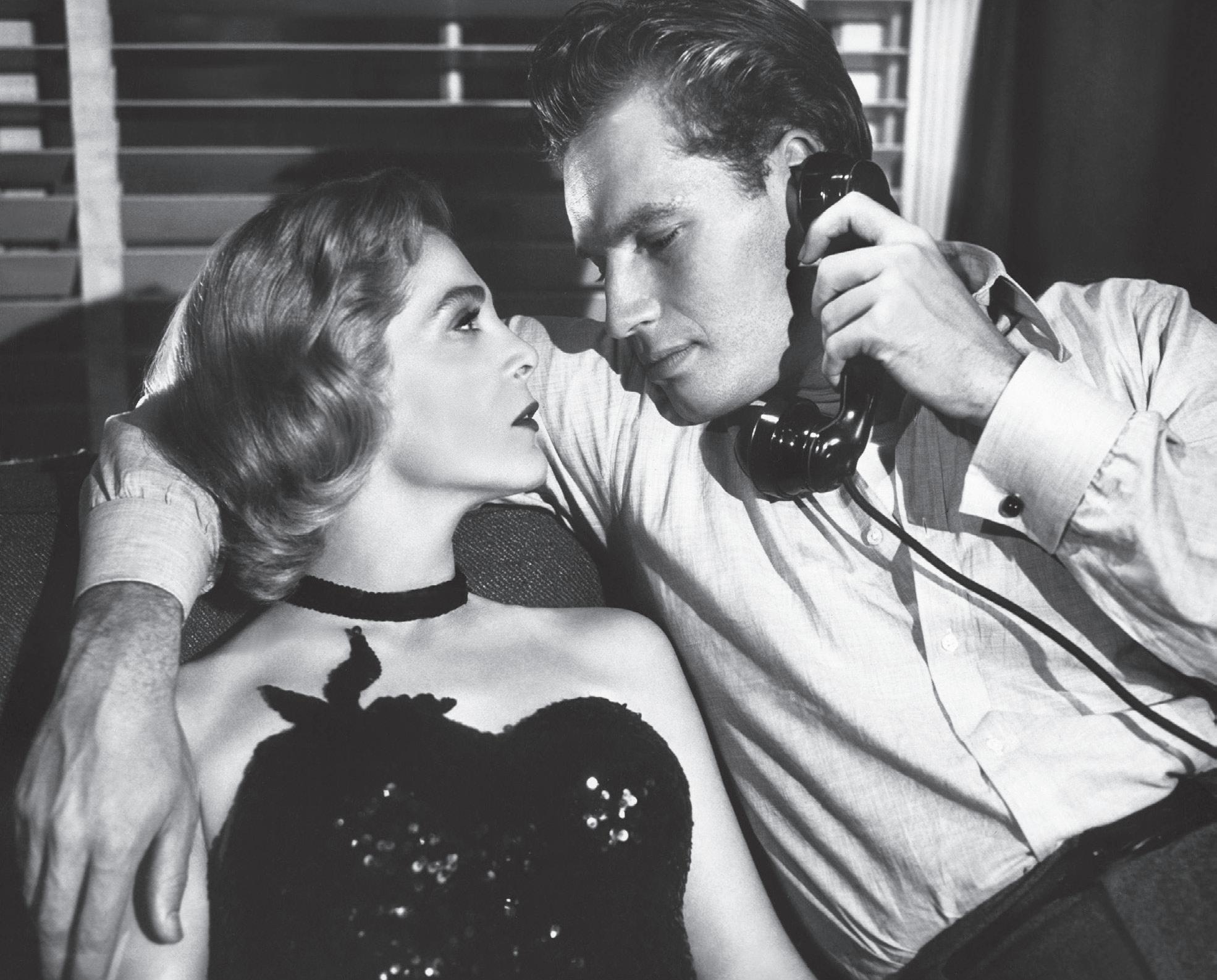
before Gershwin’s Rhapsody in Blue premiered in New York).
The music of City Noir is in the form of a 30-minute symphony. The formal and expressive weight of its three movements is distributed in pockets of high energy that are nested among areas of a more leisurely — one could even say “cinematic” — lyricism. The first movement, “The City and its Double,” opens with brief, powerful “wide-screen” panorama that gives way to a murmuring dialogue between the double bass
pizzicato and the scurrying figures in the woodwinds and keyboards. The steady tick of a jazz drummer impels this tense and nervous activity forward — a late-hour empty street scene, if you like. After a broad and lyrical melodic passage in the strings, the original scorrevole movement returns, charged with increasingly insistent impulse and building up steam until it peaks with
a full-throttle orchestral tutti. A surging melody in the horns and cellos punctuated by jabbing brass “bullets” brings the movement to a nearly chaotic climax before it suddenly collapses into shards and fragments, a sudden stasis that ushers in the second movement.
The title, “The City and its Double” is a backward glance to the French playwright Antonin Artaud, who in his writings is said to have “opposed the vitality of the viewer’s sensual experience against [a conventional concept of] theater as a contrived literary form.” Hence my “city” can be imagined not just as geographic place or even as a social nexus, but rather as a source of inex-
note. But eventually the song finds full bloom in the voice of the solo trombone, a “talking” solo, in the manner of the great Ellington soloists Lawrence Brown and Britt Woodman (both, fittingly enough, Angelenos). The trombone music picks up motion and launches a brief passage of violent, centripetal energy, all focused on a short obsessive idea first stated by the sax. Once spent of its fuel, the movement returns to the quiet opening music, ending with pensive solos by the principal horn and viola.
“Boulevard Night” is a study in cinematic colors, sometimes, as in the moody “Chinatown” trumpet solo near the beginning, it is languorous and
The music should have the slightly disorienting effect of a very crowded boulevard peopled with strange characters ... the kind who only come out very late on a very hot night.
— John Adams
haustible sensual experience. As a child watching the early days of television, I remember well the program that always ended with the familiar tag line, “There are eight million stories in the Naked City. This has been one.”
As a relief to the frenzy of the first movement’s ending, “The Song is for You,” takes its time assembling itself. Gradually a melodic profile in the solo alto sax emerges from the surrounding pools of chromatically tinted sonorities. The melody yearns toward but keeps retreating from the archetypal “blue”
nocturnal; sometimes, as in the jerky stop-start coughing engine music in the staccato strings, it is animal and pulsing; and other times, as in the slinky, sinuous saxophone theme that keeps coming back, each time with an extra layer of stage makeup, it is in-your-face brash and uncouth. The music should have the slightly disorienting effect of a very crowded boulevard peopled with strange characters, like those of a David Lynch film — the kind who only come out very late on a very hot night.
— John Adams © 2009















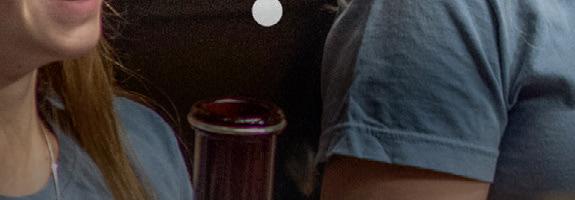
















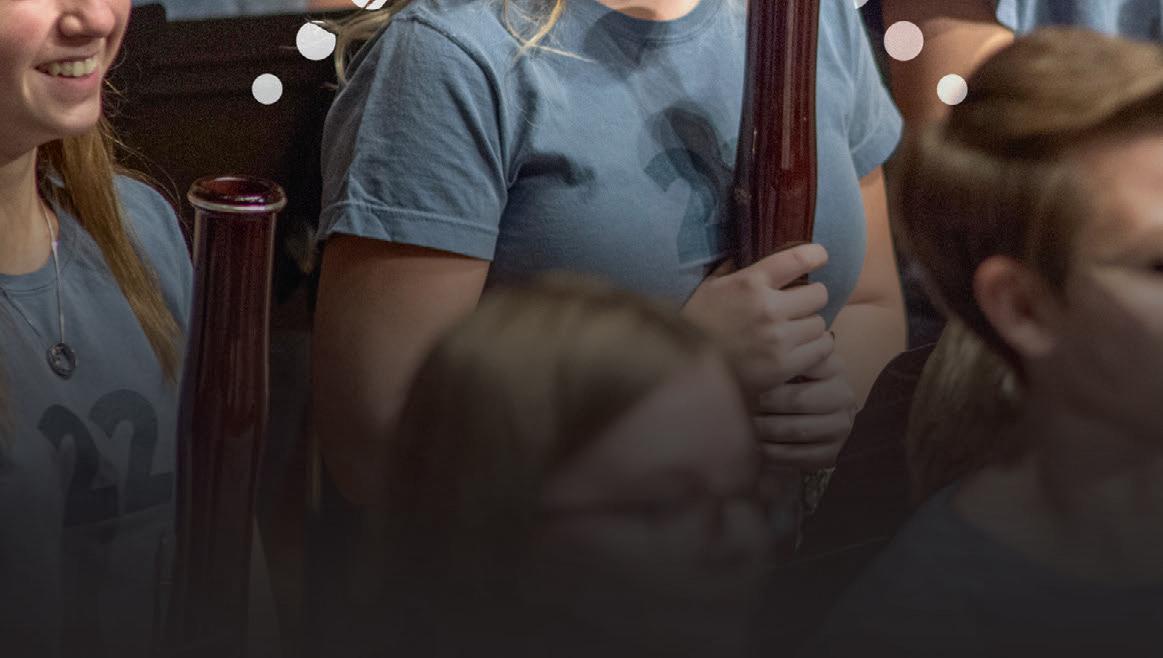





Composer, conductor, and creative thinker — John Adams occupies a unique position in the world of music. His works stand out among contemporary classical compositions for their depth of expression, brilliance of sound, and the profoundly humanist nature of their themes. His operas and oratorios such as Nixon in China, Doctor Atomic, and El Niño have transformed the genre of contemporary music theater. Spanning more than three decades, works such as Harmonielehre, Shaker Loops, The Dharma at Big Sur, and his Violin Concerto are among the most performed of all contemporary classical music.
As a conductor Adams has led the world’s major orchestras, programming his own works with a wide variety of repertoire ranging from Beethoven, Mozart, and Debussy to Sibelius, Ives, Carter, Philip Glass, and Ellington. Conducting engagements in 2023–24 include return visits to The Cleveland Orchestra and Los Angeles Philharmonic, performances with the Tokyo Metropolitan Symphony Orchestra, and the European premiere of his new opera Antony and Cleopatra at the Teatre del Liceu. Other recent engagements include performances of Girls of the Golden West with the Los Angeles Philharmonic, The Death of Klinghoffer with the Netherlands Radio Philharmonic, and appearances with the St. Louis Symphony, Rotterdam Philharmonic, and TonhalleOrchester Zürich.

A provocative writer, he is author of the highly acclaimed autobiography Hallelujah Junction and is a frequent contributor to The New York Times Book Review. Since 2009 Adams has been creative chair of the Los Angeles Philharmonic. Among his honorary doctorates are those from Yale, Harvard, Northwestern, and Cambridge universities and from The Juilliard School. In 2021 he was appointed Honorary Academician by the prestigious General Assembly of the Academicians of Santa Cecilia, and also received the Ditson Conductor’s Award from Columbia University.
In honor of Adams’s 75th birthday in 2022, Nonesuch Records released the 40-disc John Adams Collected Works, a box set of recordings spanning more than four decades of the composer’s career with the label. Also available is the Berlin Philharmonic’s John Adams Edition, a CD and DVD collection comprising seven of his works, conducted by Simon Rattle, Gustavo Dudamel, Kirill Petrenko, Alan Gilbert, and Adams himself.
Through his boundless approach to music-making, his collaborations with a vast array of artists, and his innovative programming and captivating musicianship, James McVinnie has carved out a unique career as an organist and keyboard player.
Steeped in the traditions of Anglican church music (having held organ positions at St Paul’s Cathedral and Westminster Abbey), McVinnie has since had major works written for him by Nico Muhly, Gabriella Smith, David Lang, Bryce Dessner, and Hildur Guðnadóttir, amongst many others.
He directs the James McVinnie Ensemble, a collective of virtuoso keyboardists dedicated to exploring works with political themes by contemporary and emerging composers. The ensemble’s roots go back to 2017 with a performance at London’s Barbican Centre of Philip Glass’s Music in Twelve Parts — the first time the piece was presented in concert by anyone other than the Philip Glass Ensemble. Their 2022 season featured performances of Julius Eastman’s Gay Guerrilla and Claude McKay’s 1922 poetry collection Harlem Shadows in a collaboration with the London Review of Books at Bold Tendencies. New works by Gabriella Smith and inti figgis-vizueta are planned for the Ensemble in 2024 and beyond.
McVinnie’s 2023–24 season includes the premiere of Samuel Adams’s Eden
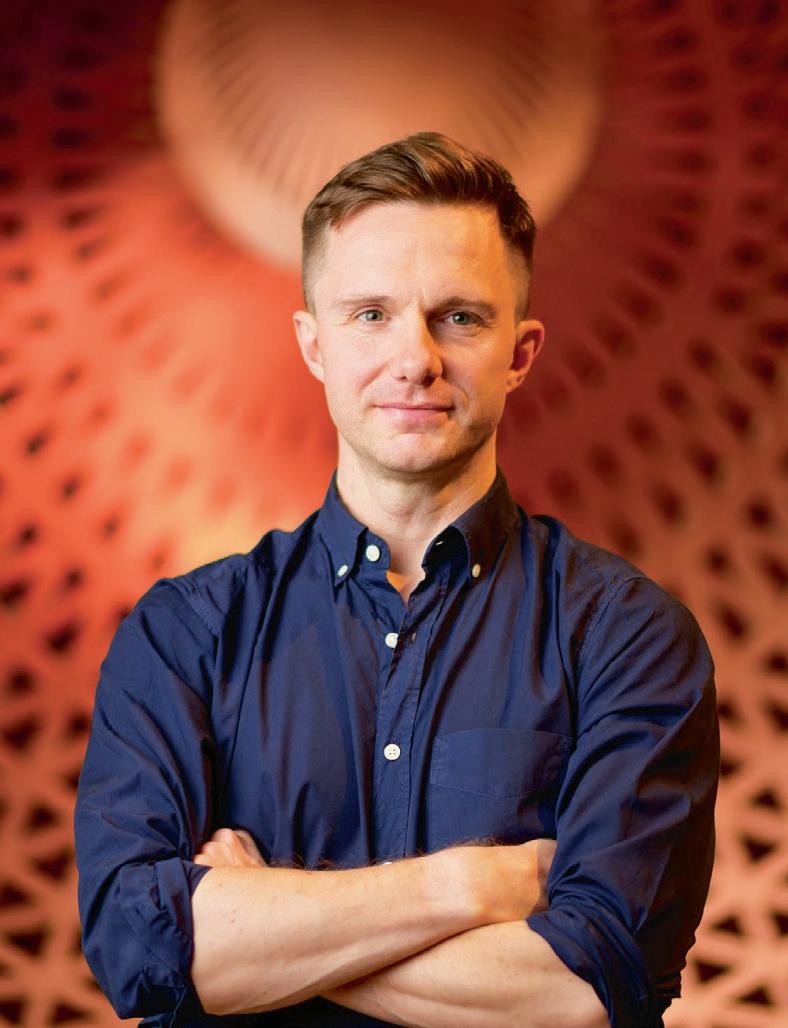
Interstates with the Los Angeles Philharmonic, a hybrid piano and organ program at Walt Disney Concert Hall, Tristan Perich’s Infinity Gradient for organ and 100 speakers in 1-bit audio at the Southbank Centre, and Nico Muhly’s Register with the Helsinki Philharmonic. Shadow Volumes, a new work for solo organ by Edmund Finnis, is planned for the 2025–26 season.
McVinnie is a member of the Icelandic collective and record label Bedroom Community, on which he has released three albums: Cycles (featuring works by Nico Muhly), Cycles_1 (a remix album), and Counterpoint (pairing music of J.S. Bach and Philip Glass). The Grid, released by Orange Mountain Music in 2018, is a studio album of music by Glass using organ samples. All Night Chroma, featuring music by Tom Jenkinson (Squarepusher), was released on Warp Records in 2019.
McVinnie started a year-long residency at London’s Southbank Centre in March 2024 with two performances in the Royal Festival Hall’s “Organ at 70” celebrations.
Today’s most celebrated classical saxophonist, Timothy McAllister is an acclaimed soloist, soprano chair of the Grammy-winning PRISM Quartet, and champion of contemporary music credited with over 50 recordings and 200 premieres of new compositions by eminent and emerging composers worldwide.
McAllister has appeared with more than 40 of the world’s most prominent orchestras in over 20 countries, from the Chicago Symphony Orchestra to the BBC Symphony Orchestra at the Proms. Following his premiere of John Adams’s Saxophone Concerto with the Sydney Symphony Orchestra under the baton of the composer, he performed the concerto and Adams’s City Noir on the 2015 Grammy Award–winning recording with the St. Louis Symphony and David Robertson. His recent recordings of Kenneth Fuchs’s saxophone concerto, Rush, with JoAnn Falletta and the London Symphony Orchestra and his reprise of City Noir with the Berlin Philharmonic under Gustavo Dudamel both appeared on 2019 Grammy-nominated albums, with the Fuchs winning Best Classical Compendium.
Recent performances include the China premiere of Adams’s Saxophone Concerto with Edo de Waart and the Hong Kong Philharmonic and the

Belgium premiere of Guillaume Connesson’s saxophone concerto, A Kind of Trane, under Stéphane Denève and the Brussels Philharmonic (which has been recorded on the Deutsche Grammophon label).
As guest soloist, other recent engagements include the symphonies of Albany, Buffalo, Detroit, Houston, Indianapolis, Milwaukee, Seattle, and St. Louis, among many others. In 2022, he premiered John Corigliano’s Triathlon with Giancarlo Guerrero and the San Francisco Symphony to widespread acclaim. 2023 featured the US premiere of Tyshawn Sorey’s Adagio (For Wadada Leo Smith) with the Atlanta Symphony Orchestra.
A widely respected teacher of his instrument, McAllister is professor of saxophone at the University of Michigan School of Music, Theatre & Dance, and he appears at summer festivals and courses worldwide. He holds degrees from the University of Michigan, having studied with legendary saxophonist Donald Sinta


Experience The Cleveland Orchestra’s digital platform with new & improved features.

NEW Concert Experiences
Experience on-demand concerts with exclusive interviews and behind-the-scenes features!
Now available: Ravel’s Piano Concerto in G major featuring Víkingur Ólafsson.
NEW Livestreamed Concerts
Enjoy six concerts broadcast live from Severance throughout the 2023 – 24 season.
Archival Audio Recordings
By popular demand, stream exclusive recordings from The Cleveland Orchestra’s audio archives.
NEW Educational Content Access videos and learning resources for children, students, and teachers.
Visit stream.adella.live/premium or scan the QR code to secure your subscription today!

Questions? Email adellahelp@clevelandorchestra.com or call 216-231-7300
NOW IN ITS SECOND CENTURY , The Cleveland Orchestra, under the leadership of Music Director Franz Welser-Möst since 2002, is one of the most sought-after performing ensembles in the world. Year after year, the ensemble exemplifies extraordinary artistic excellence, creative programming, and community engagement. The New York Times has called Cleveland “the best in America” for its virtuosity, elegance of sound, variety of color, and chamber-like musical cohesion.

Founded by Adella Prentiss Hughes, the Orchestra performed its inaugural concert in December 1918. By the middle of the century, decades of growth and sustained support had turned it into one of the most admired globally.
The past decade has seen an increasing number of young people attending concerts, bringing fresh attention to The Cleveland Orchestra’s legendary sound and committed programming. More recently, the Orchestra launched several bold digital projects, including the streaming platform Adella, the podcast On a Personal Note, and its own recording label, a new chapter in the Orchestra’s long and distinguished recording and broadcast history. Together, they have captured the Orchestra’s unique artistry and the musical achievements of the Welser-Möst and Cleveland Orchestra partnership.
The 2023 – 24 season marks Franz Welser-Möst’s 22nd year as music director, a period in which The Cleveland Orchestra earned unprecedented acclaim around the world, including a series of residencies at the Musikverein in Vienna, the first of its kind by an American orchestra, and a number of acclaimed opera presentations.
Since 1918, seven music directors — Nikolai Sokoloff, Artur Rodziński, Erich Leinsdorf, George Szell, Lorin Maazel, Christoph von Dohnányi, and Franz Welser-Möst — have guided and shaped the ensemble’s growth and sound. Through concerts at home and on tour, broadcasts, and a catalog of acclaimed recordings, The Cleveland Orchestra is heard today by a growing group of fans around the world.


FIRST VIOLINS
Jung-Min Amy Lee
ASSOCIATE CONCERTMASTER
Gretchen D. and Ward Smith Chair
Jessica Lee
ASSISTANT CONCERTMASTER
Clara G. and George P. Bickford Chair
Stephen Tavani
ASSISTANT CONCERTMASTER
Dr. Ronald H. Krasney Chair
Wei-Fang Gu
Drs. Paul M. and Renate H. Duchesneau Chair
Kim Gomez
Elizabeth and Leslie Kondorossy Chair
Chul-In Park
Harriet T. and David L. Simon Chair
Miho Hashizume
Theodore Rautenberg Chair
Jeanne Preucil Rose
Larry J.B. and Barbara S. Robinson Chair
Alicia Koelz
Oswald and Phyllis Lerner Gilroy Chair
Yu Yuan
Patty and John Collinson Chair
Isabel Trautwein
Trevor and Jennie Jones Chair
Katherine Bormann
Analisé Denise Kukelhan
Gladys B. Goetz Chair
Zhan Shu
Youngji Kim
Genevieve Smelser
SECOND VIOLINS
Stephen Rose*
Alfred M. and Clara T. Rankin Chair
Jason Yu2
James and Donna Reid Chair
Eli Matthews1
Patricia M. Kozerefski and Richard J. Bogomolny Chair
Sonja Braaten Molloy
Carolyn Gadiel Warner
Elayna Duitman
Ioana Missits
Jeffrey Zehngut
Sae Shiragami
Kathleen Collins
Beth Woodside
Emma Shook
Dr. Jeanette Grasselli Brown and Dr. Glenn R. Brown Chair
Yun-Ting Lee
Jiah Chung Chapdelaine
Liyuan Xie
VIOLAS
Wesley Collins*
Chaillé H. and Richard B. Tullis Chair
Stanley Konopka2
Mark Jackobs
Jean Wall Bennett Chair
Lisa Boyko
Richard and Nancy Sneed Chair
Richard Waugh
Lembi Veskimets
The Morgan Sisters Chair
Eliesha Nelson
Anthony and Diane Wynshaw-Boris Chair
Joanna Patterson Zakany
William Bender
Gareth Zehngut
CELLOS
Mark Kosower*
Louis D. Beaumont Chair
Richard Weiss1
The GAR Foundation Chair
Charles Bernard2
Helen Weil Ross Chair
Bryan Dumm
Muriel and Noah Butkin Chair
Tanya Ell
Thomas J. and Judith Fay
Gruber Chair
Ralph Curry
Brian Thornton
William P. Blair III Chair
David Alan Harrell
Martha Baldwin
Dane Johansen
Paul Kushious
BASSES
Maximilian Dimoff*
Clarence T. Reinberger Chair
Derek Zadinsky2
Charles Paul1
Mary E. and F. Joseph Callahan Chair
Mark Atherton
Thomas Sperl
Henry Peyrebrune
Charles Barr Memorial Chair
Charles Carleton
Scott Dixon
HARP
Trina Struble*
Alice Chalifoux Chair
FLUTES
Joshua Smith*
Elizabeth M. and William C. Treuhaft Chair
Saeran St. Christopher
Jessica Sindell2
Austin B. and Ellen W. Chinn Chair
Mary Kay Fink
PICCOLO
Mary Kay Fink
Anne M. and M. Roger Clapp Chair
OBOES
Frank Rosenwein*
Edith S. Taplin Chair
Corbin Stair
Sharon and Yoash Wiener Chair
Jeffrey Rathbun2
Everett D. and Eugenia S.
McCurdy Chair
Robert Walters
ENGLISH HORN
Robert Walters
Samuel C. and Bernette K. Jaffe Chair
CLARINETS
Afendi Yusuf*
Robert Marcellus Chair
Robert Woolfrey
Victoire G. and Alfred M.
Rankin, Jr. Chair
Daniel McKelway2
Robert R. and Vilma L. Kohn Chair
Amy Zoloto
E-FLAT CLARINET
Daniel McKelway
Stanley L. and Eloise M.
Morgan Chair
BASS CLARINET
Amy Zoloto
Myrna and James Spira Chair
BASSOONS
John Clouser*
Louise Harkness Ingalls Chair
Gareth Thomas
Barrick Stees2
Sandra L. Haslinger Chair
Jonathan Sherwin
CONTRABASSOON
Jonathan Sherwin
HORNS
Nathaniel Silberschlag*
George Szell Memorial Chair
Michael Mayhew§
Knight Foundation Chair
Jesse McCormick
Robert B. Benyo Chair
Hans Clebsch
Richard King
Meghan Guegold Hege

TRUMPETS
Michael Sachs*
Robert and Eunice Podis Weiskopf Chair
Jack Sutte
Lyle Steelman2
James P. and Dolores D. Storer Chair
Michael Miller
CORNETS
Michael Sachs*
Mary Elizabeth and G. Robert Klein Chair
Michael Miller
TROMBONES
Brian Wendel*
Gilbert W. and Louise I.
Humphrey Chair
Richard Stout
Alexander and Marianna C. McAfee Chair
Shachar Israel2
BASS TROMBONE
Luke Sieve
EUPHONIUM & BASS TRUMPET
Richard Stout
TUBA
Yasuhito Sugiyama*
Nathalie C. Spence and Nathalie S. Boswell Chair
TIMPANI
vacant PERCUSSION
Marc Damoulakis*
Margaret Allen Ireland Chair
Thomas Sherwood
Tanner Tanyeri
KEYBOARD INSTRUMENTS
Carolyn Gadiel Warner
Marjory and Marc L. Swartzbaugh Chair
LIBRARIANS
Michael Ferraguto
Joe and Marlene Toot Chair
Donald Miller
Gabrielle Petek
ENDOWED CHAIRS CURRENTLY UNOCCUPIED
Elizabeth Ring and William
Gwinn Mather Chair
Blossom-Lee Chair
Virginia M. Linsdseth, PhD, Chair
Paul and Lucille Jones Chair
Charles M. and Janet G.
Kimball Chair
Sunshine Chair
Otto G. and Corinne T. Voss Chair
Mr. and Mrs. Richard K.
Smucker Chair
Rudolf Serkin Chair
CONDUCTORS
Christoph von Dohnányi
MUSIC DIRECTOR LAUREATE
Daniel Reith
ASSISTANT CONDUCTOR
Sidney and Doris Dworkin Chair
Lisa Wong
DIRECTOR OF CHORUSES
Frances P. and Chester C.
Bolton Chair
* Principal
§ Associate Principal
1 First Assistant Principal
2
Assistant Principal
This roster lists full-time members of The Cleveland Orchestra. The number and seating of musicians onstage varies depending on the piece being performed. Seating within the string sections rotates on a periodic basis.


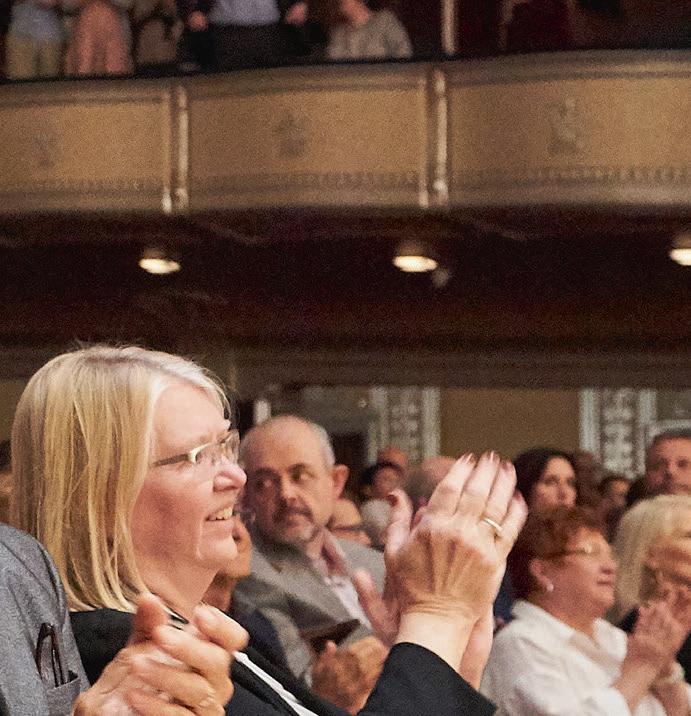





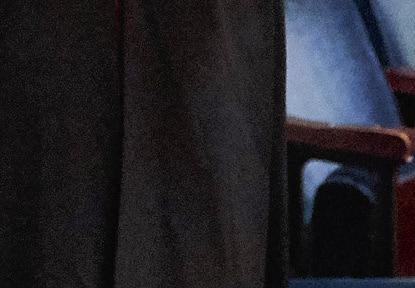

You are the magic behind every powerful performance. With this season approaching its finale, the Orchestra needs donations from friends like you to finish the year strong! Your help makes all the difference.
Be a champion for music with your donation today!

clevelandorchestra.com/give 216-456-8400
Pre-concert lectures are held in Reinberger Chamber Hall one hour prior to the performance.
APR 4 & 6
CITY NOIR
John Adams, conductor
James McVinnie, organ
Timothy McAllister, saxophone
GABRIELLA SMITH Breathing Forests
DEBUSSY Prelude to the Afternoon of a Faun
JOHN ADAMS City Noir
Pre-concert lecture by Eric Charnofsky
APR 11 – 13
ELGAR’S CELLO
CONCERTO
Klaus Mäkelä, conductor
Sol Gabetta, cello
Thomas Hampson, baritone *
The Cleveland Orchestra Chorus *
JIMMY LÓPEZ BELLIDO Perú negro
ELGAR Cello Concerto
WALTON Belshazzar’s Feast *
Pre-concert lecture by James Wilding
APR 14
RECITAL
Schumann & Brahms
Evgeny Kissin, piano
Matthias Goerne, baritone
R. SCHUMANN Dichterliebe
BRAHMS Four Ballades, Op. 10
BRAHMS Selected Songs
APR 18 – 20
YUJA WANG PLAYS
RAVEL & STRAVINSKY
Klaus Mäkelä, conductor
Yuja Wang, piano
RAVEL Concerto for the Left Hand
STRAVINSKY Concerto for Piano and Wind Instruments
STRAVINSKY The Rite of Spring
Pre-concert lecture by Caroline Oltmanns
APR 26 – 28
RACHMANINOFF’S SECOND PIANO CONCERTO
Lahav Shani, conductor
Beatrice Rana, piano
UNSUK CHIN subito con forza
RACHMANINOFF Piano Concerto No. 2
BARTÓK Concerto for Orchestra
Pre-concert lecture by James O’Leary
MAY 2 – 4
LANG LANG PLAYS
SAINT-SAËNS
Franz Welser-Möst, conductor
Lang Lang, piano *
SAINT-SAËNS Piano Concerto No. 2 *
BERLIOZ Symphonie fantastique
Pre-concert lecture by Caroline Oltmanns
MAY 15–26
* Not performed on the Friday matinee concert
2024 MANDEL OPERA & HUMANITIES FESTIVAL
For more information on festival events visit: clevelandorchestra.com/ festival
MAY 16, 18, 24 & 26
MOZART’S MAGIC FLUTE
Franz Welser-Möst, conductor
Nikolaus Habjan, director
Julian Prégardien, tenor
Ludwig Mittelhammer, baritone
Christina Landshamer, soprano
The Cleveland Orchestra Chorus
MOZART The Magic Flute
Staged production sung in German with projected supertitles
MAY 23 & 25
MOZART’S GRAN
PARTITA
Franz Welser-Möst, conductor
Leila Josefowicz, violin
Trina Struble, harp
WAGNER Prelude and Liebestod from Tristan und Isolde
JÜRI REINVERE Concerto for Violin and Harp
MOZART Serenade No. 10, “Gran
Partita”
Pre-concert lecture by Michael Strasser
For tickets & more information visit:
clevelandorchestra.com
The Cleveland Orchestra is committed to creating a comfortable, enjoyable, and safe environment for all guests at Severance Music Center. While mask and COVID-19 vaccination are recommended they are not required. Protocols are reviewed regularly with the assistance of our Cleveland Clinic partners; for up-to-date information, visit: clevelandorchestra. com/attend/health-safety
As a courtesy to the audience members and musicians in the hall, late-arriving patrons are asked to wait quietly until the first convenient break in the program. These seating breaks are at the discretion of the House Manager in consultation with the performing artists.
As a courtesy to others, please silence all devices prior to the start of the concert.
Audio recording, photography, and videography are prohibited during performances at Severance. Photographs can only be taken when the performance is not in progress.
For the comfort of those around you, please reduce the volume on hearing aids and other devices that may produce a noise that would detract from the program. For Infrared Assistive-Listening Devices, please see the House Manager or Head Usher for more details.
Contact an usher or a member of house staff if you require medical assistance. Emergency exits are clearly marked throughout the building. Ushers and house staff will provide instructions in the event of an emergency.
Regardless of age, each person must have a ticket and be able to sit quietly in a seat throughout the performance. Classical Season subscription concerts are not recommended for children under the age of 8. However, there are several age-appropriate series designed specifically for children and youth, including Music Explorers (for 3 to 6 years old) and Family Concerts (for ages 7 and older).
The Cleveland Orchestra is grateful to the following organizations for their ongoing generous support of The Cleveland Orchestra: the State of Ohio and Ohio Arts Council and to the residents of Cuyahoga County through Cuyahoga Arts and Culture.
Cleveland Orchestra performances are broadcast as part of regular programming on ideastream/WCLV Classical 90.3 FM, Saturdays at 8 PM and Sundays at 4 PM.
The Cleveland Orchestra is proud of its long-term partnership with Kent State University, made possible in part through generous funding from the State of Ohio. The Cleveland Orchestra is proud to have its home, Severance Music Center, located on the campus of Case Western Reserve University, with whom it has a long history of collaboration and partnership.
© 2024 The Cleveland Orchestra and the Musical Arts Association Program books for Cleveland Orchestra concerts are produced by The Cleveland Orchestra and are distributed free to attending audience members.
EDITORIAL
Kevin McBrien, Publications Manager
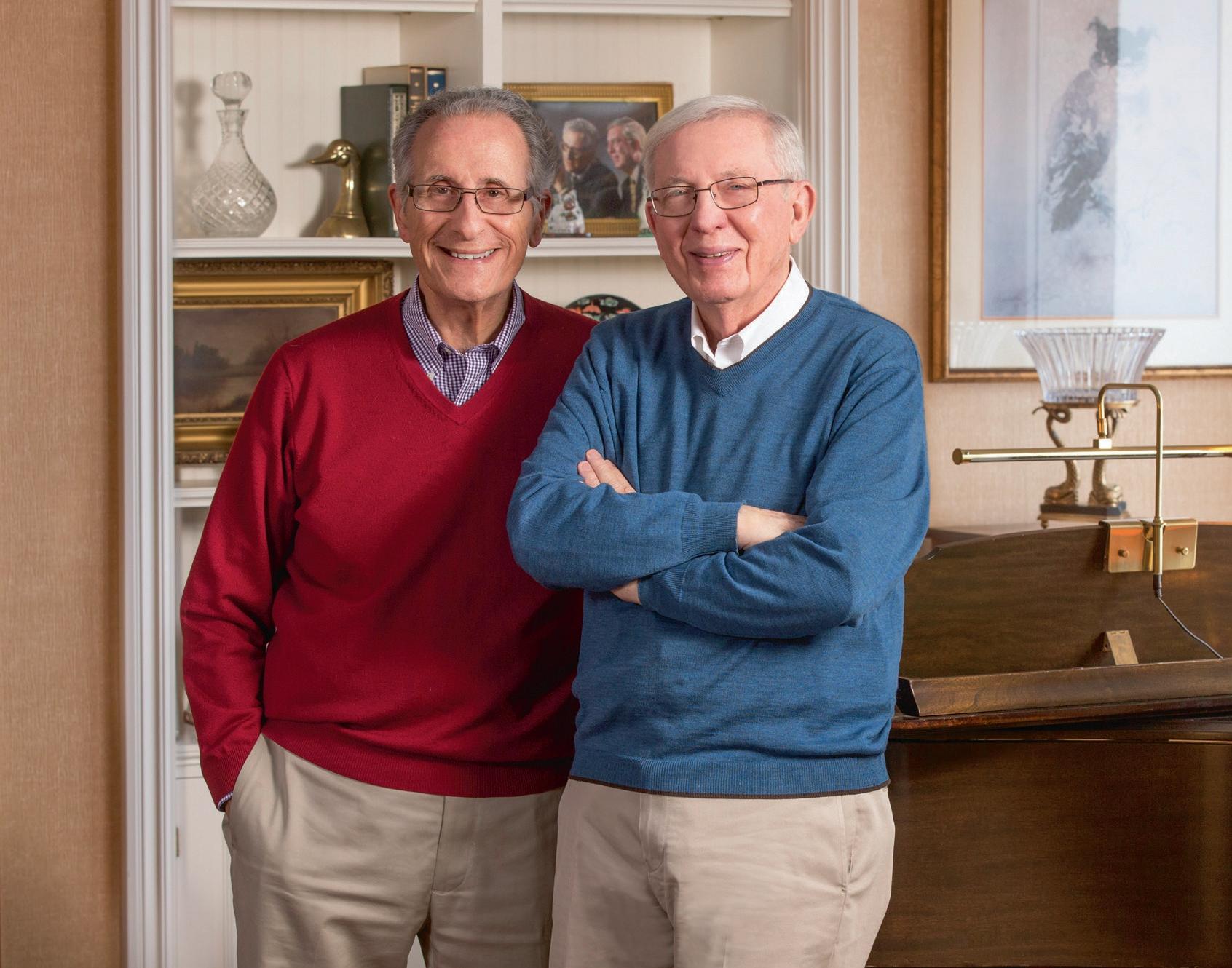
“We are paving a path for our next chapter by establishing connections now. We can keep enjoying our wonderful skyline views and musical activities, knowing our plan is in place.”
As a Judson at Home member, you’ll have access to an engaging community, cultural programs, wellness activities and an array of dining venues. Most of all, you have all the services and amenities of a retirement community at your fingertips while living in your own home.




We believe that all Cleveland youth should have access to high-quality arts education. Through the generosity of our donors, we have invested more than $12.6 million since 2016 to scale up neighborhood-based programs that serve thousands of youth year-round in music, dance, theater, photography, literary arts and curatorial mastery. That’s setting the stage for success. Find your passion, and partner with the Cleveland Foundation to make your greatest charitable impact.
(877) 554-5054
www.ClevelandFoundation.org/Success
